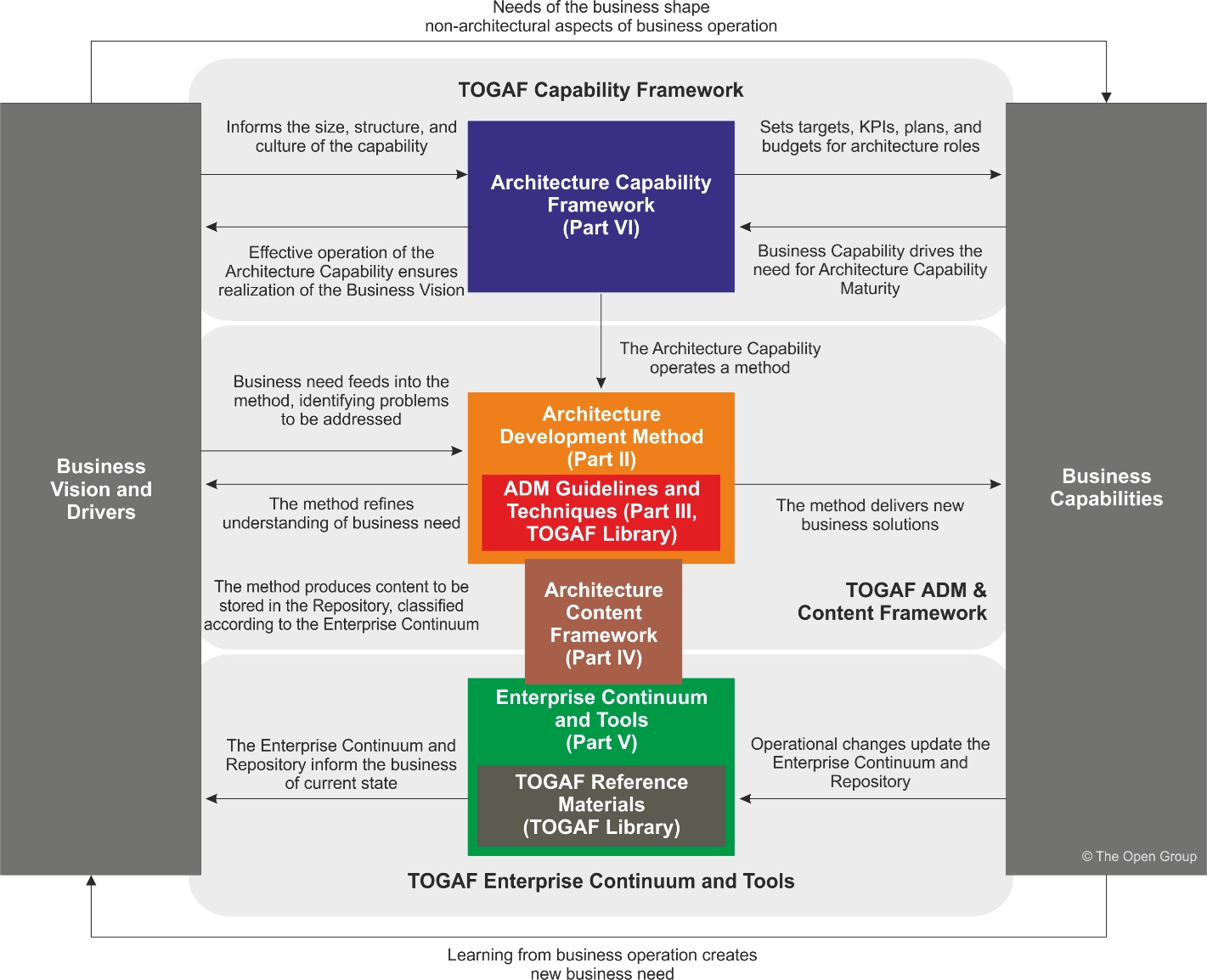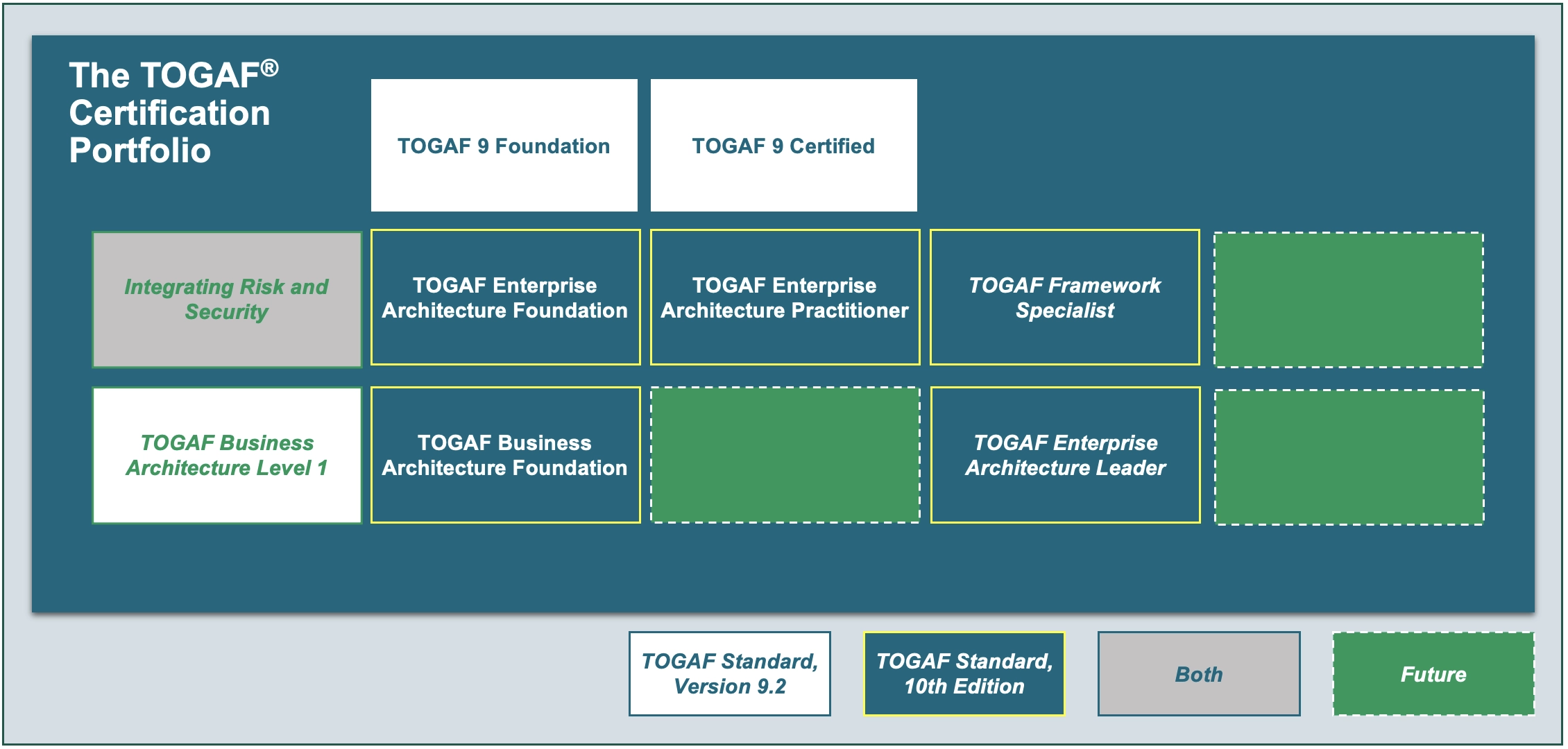TOGAF® Standard, Version 9.2 vs. TOGAF® Standard, 10th Edition
Differences between TOGAF Standard, Version 9.2 and TOGAF Standard, 10th Edition explained by iLEARN
Summary of Topics
- What is TOGAF® framework?
- Which versions of TOGAF framework are available?
- What is the content of TOGAF® Standard, Version 9.2?
- What is the content of TOGAF Standard, 10th Edition?
- What is the difference between TOGAF, Version 9.2 and TOGAF Standard, 10th Edition?
- What are the TOGAF Standard key benefits?
- What is the TOGAF certification portfolio?
- Which TOGAF® certification is right for me?
- How can I achieve a TOGAF certification?
What is TOGAF® framework?
The TOGAF® framework, a The Open Group Standard, is a proven Enterprise Architecture methodology and framework used by the world's leading organizations to improve business efficiency. It is the most prominent and reliable Enterprise Architecture standard, ensuring consistent standards, methods, and communication among Enterprise Architecture professionals. Enterprise Architecture professionals fluent in the TOGAF® Standard enjoy greater industry credibility, job effectiveness, and career opportunities.
Which versions of TOGAF framework are available?
Developed by The Open Group in 1995, TOGAF framework is one of the most widely used enterprise architecture frameworks today. It’s used by small, medium, and large businesses as well as government departments, non-government public organizations, and defense agencies. The Open Group announced the latest update to the framework, releasing the TOGAF® Standard, 10th Edition early in 2022.
There are currently two supported version of the TOGAF Standard supported by the Open Group as we will see discussing the TOGAF Certification Portfolio later: Version 9.2 and 10th Edition.
What is the content of TOGAF® Standard, Version 9.2?
The TOGAF Standard, Version 9.2 is an update (released in 2018) to the TOGAF® Version 9.1 (released 9 years before) providing improved guidance, correcting errors, improving the document structure, and removing obsolete content. Key enhancements made in this version include updates to the Business Architecture and the Content Metamodel. All of these changes make the TOGAF framework easier to use and maintain.

The standard is divided into seven parts, reflecting the structure and content of an Architecture Capability within an enterprise (described in the figure above):
- PART I (Introduction): This part provides a high-level introduction to the key concepts of Enterprise Architecture and in particular the TOGAF standard approach. It contains the definitions of terms used throughout the TOGAF framework and release notes detailing the changes between this version and the previous version of TOGAF framework.
- PART II (Architecture Development Method): This is the core of the TOGAF framework. It describes the TOGAF Architecture Development Method (ADM) – a step-by-step approach to developing an Enterprise Architecture.
- PART III (ADM Guidelines & Techniques): This part contains a collection of guidelines and techniques available for use in applying the TOGAF standard and the TOGAF ADM.
- PART IV (Architecture Content Framework): This part describes the TOGAF content framework, including a structured metamodel for architectural artifacts, the use of re-usable architecture building blocks, and an overview of typical architecture deliverables.
- PART V (Enterprise Continuum & Tools): This part discusses appropriate taxonomies and tools to categorize and store the outputs of architecture activity within an enterprise.
- PART VI (TOGAF Reference Models): This part provides a selection of architectural reference models, which includes the TOGAF Foundation Architecture, and the Integrated Information Infrastructure Reference Model (III-RM).
- PART VII (Architecture Capability Framework): This part discusses the organization, processes, skills, roles, and responsibilities required to establish and operate an architecture function within an enterprise.
What is the content of TOGAF Standard, 10th Edition?
The TOGAF ADM, or 'Architectural Development Method', remains at the core of the framework in the TOGAF latest version. Although the newer version of the framework hasn't altered this, it has been divided into two separate areas: TOGAF Fundamental Content and TOGAF Series Guides, which is a significant change in TOGAF Standard, 10th Edition.
The framework's backbone is the TOGAF Fundamental Content, which comprises an introduction and implementation advice and delves into the details of the following aspects:
- The Architectural Development Method
- ADM techniques
- Applying the ADM
- Architecture content
- EA capability and governance
Individuals who have studied or utilized TOGAF Standard, version 9.2 will find this section of the framework to be quite familiar.
The TOGAF Series Guides provide supplementary information to the main framework, with a detailed focus on the following areas of architecture:
- Business architecture
- Security architecture
- Information architecture
- Enterprise architecture
- Technology architecture
- Digital architecture
Additional guides offer information on topics such as Agile, adapting the ADM, MSA and SOA architectures, and more. This format offers greater flexibility to TOGAF practitioners, who can refer to and use the Series Guides as required, depending on organizational structure, goals, environments, and other factors.
The Open Group has also committed to creating and updating guides in the future, expanding the TOGAF body of knowledge and making the framework even more adaptable and applicable.
What is the difference between TOGAF, Version 9.2 and TOGAF Standard, 10th Edition?
The core content of TOGAF (the ADM) is unchanged between the two versions.
However, TOGAF Standard, 10th Edition has been made more navigable, expandable and easier to customize. On this basis, key knowledge was added on recent and emerging topics such as agility, micro services architecture, digital strategy.
What are the TOGAF Standard key benefits?
Like most frameworks, the TOGAF Standard provides a way for organizations to increase the robustness, flexibility and efficiency of their Enterprise Architecture, enabling the business to change and adapt to the requirements of an unpredictable future. But what are the advantages of the TOGAF standard over other EA frameworks?
- Collaborative: the TOGAF framework was developed through the combined efforts of 300 of the world’s leading organizations. This broad base of knowledge and experience ensures that the framework is tried and tested.
- Open-source resource: The volume of materials found in the TOGAF framework is unmatched and is available for free via the Open Group’s website. These resources are a valuable resource for novice and experienced practitioners alike.
- Flexible: The TOGAF framework is general but can be tailored to suit the specific needs of any organization. In addition, it has been designed to be compatible with other frameworks.
- Popular: The TOGAF framework has been around for a long time, and as a result it is widely known and accepted, and there are a large number of qualified practitioners and trainers available. This means that it is easy to find people with the right skills when you need them.
- Constantly improving: The TOGAF framework evolves with each update, ensuring that it incorporates and promotes the latest best practices.
What is the TOGAF certification portfolio?
The TOGAF certification portfolio includes certifications and certification credentials built upon the TOGAF Standard, Version 9.2, and the TOGAF Standard, 10th Edition.
It includes a set of complementary learning paths centered around the TOGAF Standard, and the TOGAF Library. The paths include different amounts of learning, ranging from short certification credentials (3 hours study or more) to multi-day certifications.

The TOGAF certifications included in the portfolio are the following.
Please check the links below to see the related TOGAF training:
- TOGAF 9 Foundation
- TOGAF 9 Certified
- TOGAF Enterprise Architecture Foundation
- TOGAF Enterprise Architecture Practitioner
- TOGAF Business Architecture Foundation
Learning paths introduced to support the TOGAF Standard, 10th Edition include direct paths from TOGAF 9 Foundation certification and upwards, and recognition of TOGAF 9 certification with the Bridge path.
Which TOGAF® certification is right for me?
The table below provides guidelines to select the right TOGAF certification based on the status and the needs of a candidate.

How can I achieve a TOGAF certification?
To achieve a TOGAF certification, you shall follow an accredited course and pass the related exam.
Learn more about our courses and the certification exams for the corresponding level by clicking the links below:
- TOGAF® EA Foundation - Online, virtual and in classroom
- TOGAF® EA Practitioner - Online, virtual and in classroom
- TOGAF® EA Practitioner Bridge - Online, virtual and in classroom
- TOGAF® EA Foundation & Practitioner Combined - Online, virtual and in classroom
- TOGAF® BA Foundation - Online

 Login
Login